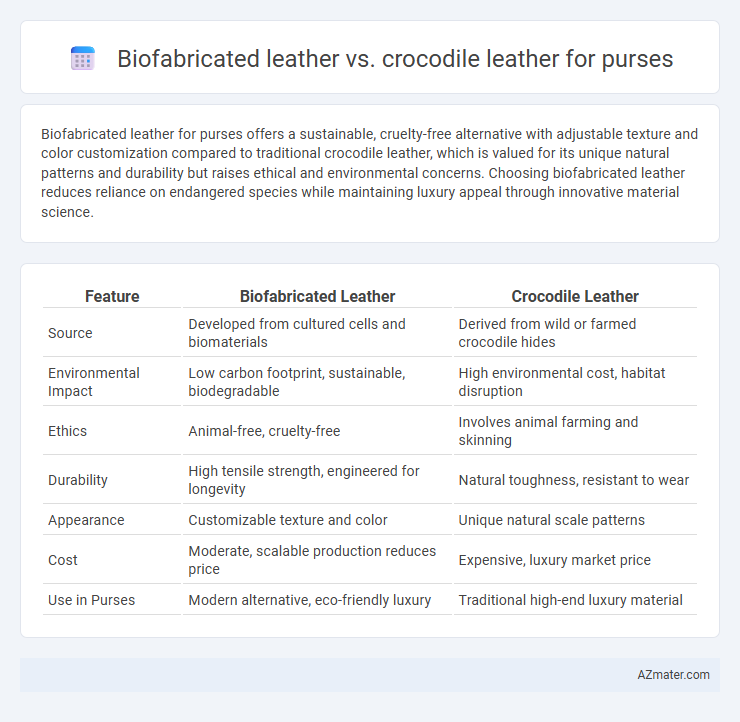Biofabricated leather for purses offers a sustainable, cruelty-free alternative with adjustable texture and color customization compared to traditional crocodile leather, which is valued for its unique natural patterns and durability but raises ethical and environmental concerns. Choosing biofabricated leather reduces reliance on endangered species while maintaining luxury appeal through innovative material science.
Table of Comparison
| Feature | Biofabricated Leather | Crocodile Leather |
|---|---|---|
| Source | Developed from cultured cells and biomaterials | Derived from wild or farmed crocodile hides |
| Environmental Impact | Low carbon footprint, sustainable, biodegradable | High environmental cost, habitat disruption |
| Ethics | Animal-free, cruelty-free | Involves animal farming and skinning |
| Durability | High tensile strength, engineered for longevity | Natural toughness, resistant to wear |
| Appearance | Customizable texture and color | Unique natural scale patterns |
| Cost | Moderate, scalable production reduces price | Expensive, luxury market price |
| Use in Purses | Modern alternative, eco-friendly luxury | Traditional high-end luxury material |
Introduction to Biofabricated and Crocodile Leather
Biofabricated leather is an innovative, sustainable material created through cellular agriculture, offering an ethical alternative to animal-derived products by growing collagen fibers in a lab environment. Crocodile leather, prized for its distinctive texture and durability, is sourced from the hides of crocodiles, often associated with luxury fashion accessories such as purses. The choice between biofabricated and crocodile leather balances considerations of environmental impact, ethical sourcing, and the unique aesthetic qualities valued in premium handbags.
Key Differences in Material Composition
Biofabricated leather used for purses is derived from lab-grown collagen fibers designed to mimic animal leather without the environmental and ethical concerns associated with traditional leather production. Crocodile leather, sourced from the skin of crocodiles, is characterized by its unique scale patterns, high durability, and natural texture, making it a luxury material with significant ecological impact. The primary difference in material composition lies in biofabricated leather's synthetic collagen matrix versus crocodile leather's natural dermal tissue, influencing factors like breathability, flexibility, and sustainability.
Environmental Impact: Sustainability Comparison
Biofabricated leather significantly reduces environmental impact compared to crocodile leather by eliminating the need for animal farming, which typically involves high water consumption, deforestation, and greenhouse gas emissions. Crocodile leather production contributes to habitat disruption and often relies on chemical-intensive tanning processes that pollute water sources. The sustainable nature of biofabricated leather supports reduced land use, lower carbon footprint, and minimizes ethical concerns associated with wildlife exploitation.
Durability and Longevity of Each Leather
Biofabricated leather offers consistent durability due to its engineered structure, resisting wear and tear while maintaining flexibility over time. Crocodile leather, prized for its natural toughness and unique scale pattern, exhibits exceptional longevity but requires proper care to prevent drying and cracking. Both materials provide premium durability; biofabricated leather excels in uniform performance, whereas crocodile leather combines strength with classic luxury aging gracefully with use.
Ethical Considerations and Animal Welfare
Biofabricated leather offers a significant ethical advantage over crocodile leather by eliminating the need to harm or kill animals, aligning with growing consumer demand for cruelty-free products. The production of biofabricated leather reduces environmental impact and animal suffering, addressing concerns linked to the farming and harvesting of crocodiles for their hides. Choosing biofabricated leather purses supports sustainable practices and advances animal welfare by promoting alternatives to traditional exotic leather sourcing.
Aesthetic Appeal and Customization Options
Biofabricated leather offers a sleek, uniform aesthetic with the ability to tailor colors, textures, and patterns to specific design preferences, enhancing customization for purses. Crocodile leather is prized for its natural, luxurious texture and unique scale patterns, giving each purse an individual and prestigious appearance. Customization options for crocodile leather are limited to dyeing and finishing techniques, making biofabricated leather more versatile for personalized styles.
Cost Analysis: Production and Retail Prices
Biofabricated leather presents a cost-efficient alternative to crocodile leather by reducing expenses in raw materials and ethical sourcing, leading to lower production costs per square foot. Crocodile leather involves high costs due to animal farming, lengthy curing processes, and limited supply, resulting in premium retail prices often exceeding $1,500 per purse. Purse manufacturers adopting biofabricated leather can offer competitive pricing below $800, appealing to eco-conscious consumers while maintaining quality and durability.
Consumer Perception and Luxury Branding
Biofabricated leather is increasingly favored by environmentally conscious consumers, who perceive it as a sustainable and ethical alternative to traditional crocodile leather, aligning with modern luxury branding's shift towards responsible sourcing. Crocodile leather maintains its prestige and exclusivity, often associated with heritage craftsmanship and opulence, but faces scrutiny over animal welfare concerns that can affect brand reputation. Luxury brands leveraging biofabricated leather capitalize on innovation and eco-luxury narratives, appealing to younger, eco-aware demographics while preserving high-end exclusivity through premium design and texture quality.
Care and Maintenance Requirements
Biofabricated leather for purses requires less intensive care compared to crocodile leather, as it is generally more resistant to water, stains, and cracking. Crocodile leather demands specialized maintenance including regular conditioning with oils to preserve its natural texture and prevent drying or cracking. Both materials benefit from storage in cool, dry places away from direct sunlight to extend their lifespan.
Future Trends in Leather Alternatives for Fashion
Biofabricated leather, created through sustainable cellular agriculture, offers a cruelty-free and environmentally friendly alternative to traditional crocodile leather, which involves intensive animal farming and habitat impact. As fashion brands prioritize eco-conscious materials, biofabricated leather is gaining traction for its customizable texture and reduced carbon footprint compared to exotic skins. Future trends in leather alternatives highlight innovations in biofabrication and plant-based materials, aiming to meet luxury standards while addressing ethical and ecological concerns inherent in crocodile leather production.

Infographic: Biofabricated leather vs Crocodile leather for Purse
 azmater.com
azmater.com